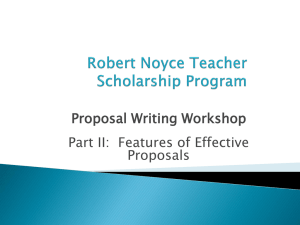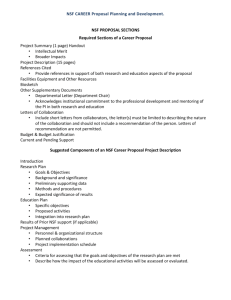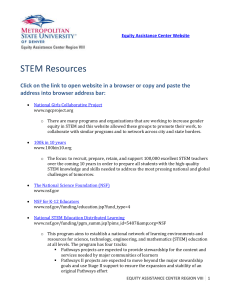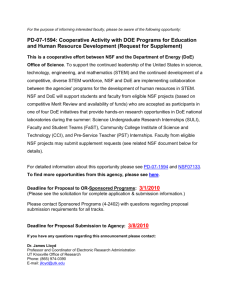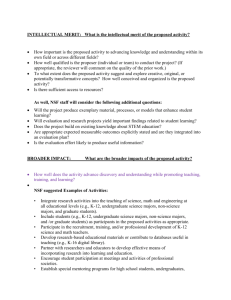- Teaching Commons Guide for MERLOT Partners
advertisement
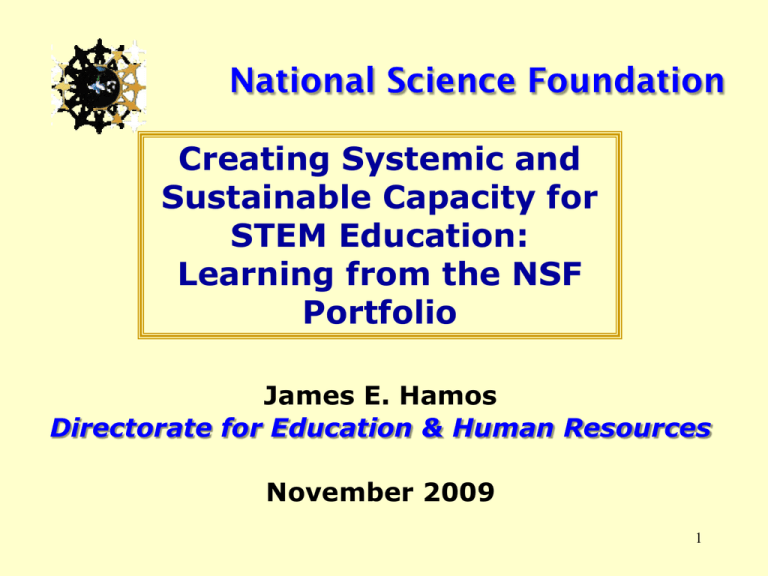
National Science Foundation Creating Systemic and Sustainable Capacity for STEM Education: Learning from the NSF Portfolio James E. Hamos Directorate for Education & Human Resources November 2009 1 Today's young people face a world of increasing global competition. We depend on the excellence of U.S. schools and universities to provide students with the wherewithal to meet this challenge and to make their own contributions to America's future. Dr. Arden L. Bement, Jr. Director, NSF Committee on Science, U.S. House of Representatives, Hearing on K-12 Science and Math Education Across 2 Federal Agencies -- March 30, 2006 Enabling the Nation’s future through discovery, learning and innovation To promote the progress of science; to advance the national health, prosperity, and welfare; to secure the national defense; and for other purposes Basic scientific research and research fundamental to the engineering process, Programs to strengthen scientific and engineering research potential, Science and engineering education programs at all levels and in all fields of science and engineering, and An information base on science and engineering appropriate for development of national and international policy. from National Science Foundation Act of 1950 3 NSF Strategic Goals Discovery Advance the frontiers of knowledge Learning Cultivate a world-class, inclusive science and engineering workforce Research infrastructure Build research capability via advanced instrumentation, facilities, cyberinfrastructure and experimental tools Stewardship Support excellence and ensure a capable and responsive organization NSF Organization Chart 5 NSF Considers Proposals for Support of Research in any Field of Science Astronomy Atmospheric Sciences Biological Sciences Chemistry Computer Sciences Earth Sciences Education and Human Resources Engineering Information Science Materials Research Mathematical Sciences Nanotechnology Oceanography Physics Polar Studies Social, Behavioral and Economic Sciences Interdisciplinary/Cross-cutting Proposals 6 NSF/EHR Goals Prepare the next generation of STEM professionals and attract and retain more Americans to STEM careers. Develop a robust research community that can conduct rigorous research and evaluation that will support excellence in STEM education and that integrates research and education. Increase the technological, scientific and quantitative literacy of all Americans so that they can exercise responsible citizenship and live productive lives in an increasingly technological society. Broaden participation (individuals, geographic regions, types of institutions, STEM disciplines) and close achievement gaps in all STEM fields. 7 EHR’s Funding FY 2007 Total – $695.65 million (out of $6.095 billion total for NSF) • • • • DRL DUE DGE HRD $208.99 $204.96 $155.90 $125.80 million million million million FY 2009 Omnibus – $845.26 million, 21.5% increase (out of $6.490 billion total for NSF) American Recovery and Reinvestment Act of 2009 – additional $100 million (out of $3.002 billion additional to NSF) Math and Science Partnership (MSP) Program A Research and Development Effort in K-16 Teaching and Learning NSF’s Math and Science Partnership A research & development effort at NSF for building capacity and integrating the work of higher education with that of K-12 to strengthen and reform mathematics and science education Launched in FY 2002 as a result of legislative interest and was also a key facet of the President’s NCLB vision for K-12 education Reauthorized as part of the America COMPETES Act of 2007 and provided with additional appropriation in the American Recovery and Reinvestment Act of 2009 and the FY 2009 federal budget Through the Math and Science Partnership program, NSF awards competitive, merit-based grants to teams composed of institutions of higher education, local K-12 school systems and supporting partners. At their core, Partnerships contain at least one institution of higher education and one K-12 school system. 145 Funded MSP Projects 12 Comprehensive Partnerships (FY 2002, FY 2003) 36 Targeted Partnerships (FY 2002, FY 2003, FY 2004, FY 2008) 23 Institute Partnerships (Prototype Award in FY 2003, FY 2004, FY 2006, FY 2008, FY 2009) 19 MSP-Start Partnerships (FY 2008, FY2009) 6 Phase II Partnerships (FY 2008, FY 2009) 49 RETA projects (Design Awards in FY 2002, FY 2003, FY 2004, FY 2006, FY 2008, FY 2009) Scope of Partnership Projects Over 800 K-12 school districts ~5 million students ~147,000 teachers of K-12 math and science 198 institutions of higher education Over 2600 faculty, administrators, graduate and undergraduate students Math and Science Partnership (MSP) Program National Distribution of Partnership Activity 14 Examining Student Achievement Year-by-Year Trend Analysis Matched comparisons Meta-analysis pre/post assessments Closing the Achievement Gap What are we learning? Through new long-term and coherent courses and programs, the involvement of STEM faculty and their departments in pre- and in-service education enhances content knowledge of teachers North Cascades and Olympic Science Partnership Impact on Teacher Leaders’ Content Knowledge 60 48.6 48.6 Impact on the Students of Teacher Leaders % Proficient 50 40 43.7 39.4 39.2 42.4 0 Years with a NCOSP Teacher 1 Year with a NCOSP Teacher 30 2 Years with a NCOSP Teacher 20 10 0 N = 7408 1927 368 5th Grade 2949 1819 327 10th Grade Students who have NCOSP teacher leaders for one and two years of instruction are more likely to score proficient on state assessments than students who do not have such a teacher. What are we learning? MSP projects are making new contributions to the STEM education literature related to teacher content knowledge and teacher leadership Teacher Content Knowledge & Teacher Leadership http://www.mspkmd.net/ What are we learning? STEM professional learning communities are new exemplars in professional development Rice University Mathematics Leadership Institute What are we learning? STEM education can and should extend beyond science and mathematics; in particular, K-12 engineering education is ready for prime time What are we learning? Higher education STEM faculty, often with the aid of teachers-inresidence on college campuses, are broadening their discussions of teaching and learning and supporting new efforts in teacher preparation What are we learning? Research methods in ethnography and social network analysis help document change in institutions and partnerships Milwaukee Mathematics Partnership School with High Distributed Leadership School with Emerging Distributed Leadership • Distance is important. Closer nodes are more tightly connected than nodes that are further apart. • Color is important. Individuals from the subject school are colored red and those who are not at the school are green. The MTL for each school is colored yellow. • Shape denotes role as follows: Diamond = MTL; Overlapping Triangles = Principal; Up Triangle = Literacy Coach; Down Triangle = MTS; Square = Teacher; Circle = Other role What are we learning? New centers and institutes devoted to K-16 math and science education facilitate interactions between higher education and K-12, offer professional development for STEM faculty, and advance the scholarship of teaching and learning Enhancing Support of Transformative Research at the National Science Foundation (NSB 07-32) http://www.nsf.gov/nsb/documents/2007/tr_report.pdf 27 Enhancing Support of Transformative Research at the National Science Foundation Science progresses in two fundamental and equally valuable ways. The vast majority of scientific understanding advances incrementally, with new projects building upon the results of previous studies or testing long-standing hypotheses and theories. This progress is evolutionary—it extends or shifts prevailing paradigms over time. The vast majority of research conducted in scientific laboratories around the world fuels this form of innovative scientific progress. Less frequently, scientific understanding advances dramatically, through the application of radically different approaches or interpretations that result in the creation of new paradigms or new scientific fields. This progress is revolutionary, for it transforms science by overthrowing entrenched paradigms and generating new ones. 28 Transformative Research – Notice No. 130 Endeavors which have the potential to change the way we address challenges in science, engineering, and innovation. Those endeavors which promise extraordinary outcomes, such as: revolutionizing entire disciplines; creating entirely new fields; or disrupting accepted theories and perspectives. Director Arden Bement, Notice No. 130, September 24, 2007, Important Notice To Presidents of Universities and Colleges and Heads Of Other National Science Foundation Awardee Organizations http://www.nsf.gov/pubs/2007/in130/in130.jsp 29 EArly-concept Grants for Exploratory Research (EAGER) Replaces part of the Small Grants for Exploratory Research (SGER) program Supports high-risk, exploratory and potentially transformative research Requests may be for up to $300K and of up to two years duration Further guidelines in Grant Proposal Guide (NSF 09-1, January 2009), Chapter II, Section D (Special Guidelines), Subsection 2 30
